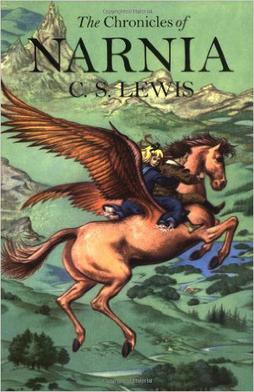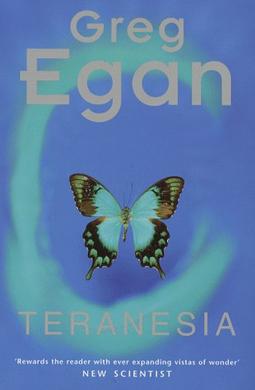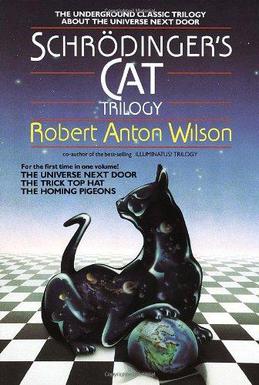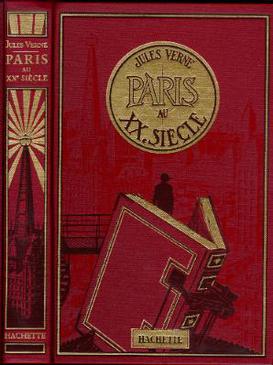British science fiction writer Arthur C. Clarke formulated three adages that are known as Clarke's three laws, of which the third law is the best known and most widely cited. They are part of his ideas in his extensive writings about the future.
Greg Egan is an Australian science fiction writer and mathematician, best known for his works of hard science fiction. Egan has won multiple awards including the John W. Campbell Memorial Award, the Hugo Award, and the Locus Award.

A point of view shot is a film scene—usually a short one—that is shot as if through the eyes of a character. The camera shows what the subject's eyes would see. It is usually established by being positioned between a shot of a character looking at something, and a shot showing the character's reaction. The POV technique is one of the foundations of film editing.

The Chronicles of Narnia is a series of seven portal fantasy novels by British author C. S. Lewis. Illustrated by Pauline Baynes and originally published between 1950 and 1956, the series is set in the fictional realm of Narnia, a fantasy world of magic, mythical beasts and talking animals. It narrates the adventures of various children who play central roles in the unfolding history of the Narnian world. Except in The Horse and His Boy, the protagonists are all children from the real world who are magically transported to Narnia, where they are sometimes called upon by the lion Aslan to protect Narnia from evil. The books span the entire history of Narnia, from its creation in The Magician's Nephew to its eventual destruction in The Last Battle.
A parallel universe, also known as an alternate universe, parallel world, parallel dimension, alternate reality, or alternative dimension, is a hypothetical universe co-existing with one's own, typically distinct in some way. The sum of all potential parallel universes that constitute reality is often called the "multiverse". Another common term for a parallel universe is "another dimension", stemming from the idea that if the 4th dimension is time, the 5th dimension—a direction at a right angle to the fourth—is a direction into any of the alternate spacetime realities.

Axiomatic (ISBN 0-7528-1650-0) is a 1995 collection of short science fiction stories by Greg Egan. The stories all delve into different aspects of self and identity.

Teranesia is a 1999 science fiction novel by Greg Egan. The novel follows protagonist Prabir Suresh, who lives on an island in the South Moluccas with his biologist parents, who are investigating the unique evolutionary traits of butterflies on the island. As civil war erupts in Indonesia, Prabir and his baby sister Madhusree must escape the islands. When they grow up, Madhusree becomes a biology student, motivated to carry on her parents' legacy in uncovering the evolutionary phenomenon. Prabir reluctantly follows her, as he must navigate and confront the truth that shaped his past.

The Voyage of the Dawn Treader is a portal fantasy novel for children written by C. S. Lewis, published by Geoffrey Bles in 1952. It was the third published of seven novels in The Chronicles of Narnia (1950–1956). Macmillan US published an American edition within the calendar year, with substantial revisions which were retained in the United States until 1994. It is volume five in recent editions, which are sequenced according to the novels' internal chronology. Like the other Chronicles of Narnia, The Voyage of the Dawn Treader was illustrated by Pauline Baynes, and her work has been retained in many later editions.

The Schrödinger's Cat Trilogy is a trilogy of novels by American writer Robert Anton Wilson consisting of Schrödinger's Cat: The Universe Next Door (1979), Schrödinger's Cat II: The Trick Top Hat (1980), and Schrödinger's Cat III: The Homing Pigeons (1981), each illustrating a different interpretation of quantum physics. They were collected into an omnibus edition in 1988.

Distress is a 1995 science fiction novel by Australian writer Greg Egan.

Paris in the Twentieth Century is a science fiction novel by Jules Verne. The book presents Paris in August 1960, 97 years in Verne's future, when society places value only on business and technology.
The Laundry Files is a series of novels by British writer Charles Stross. They mix the genres of Lovecraftian horror, spy thriller, science fiction, and workplace humour. Their main character for the first five novels is "Bob Howard", a one-time I.T. consultant turned occult field agent. Howard is recruited to work for the Q-Division of SOE, otherwise known as "the Laundry", the British government agency which deals with occult threats. "Magic" is described as being a branch of applied computation (mathematics), therefore computers and equations are just as useful, and perhaps more potent, than classic spellbooks, pentagrams, and sigils for the purpose of influencing ancient powers and opening gates to other dimensions. These occult struggles happen largely out of view of the public, as the Laundry seeks to keep the methods for contacting such powers under wraps. There are also elements of dry humour and satirisation of bureaucracy.
A Bao A Qu is a legendary Malay creature described in Jorge Luis Borges's 1967 Book of Imaginary Beings. Borges claimed to have found it either in an introduction to the Arabian Nights by Richard Francis Burton, or in the book On Malay Witchcraft (1937) by C.C. Iturvuru. The Burton reference was given in the original Spanish, but it was changed to the Iturvuru reference in the English text, possibly to make it sound more exotic, or as a reference to Borges' friend C. C. Iturburu. The writer Antares conjectures that Borges's tale might be inspired by Orang Asli myth, and that "A Bao A Qu" is a slurring of abang aku meaning "my elder brother".

"Un-Man" is a science fiction novella by American writer Poul Anderson, first published in the January 1953 issue of Astounding Science Fiction. It was included in the 1962 collection Un-Man and Other Novellas, and the 1981 collection The Psychotechnic League. As a component of the Psychotechnic League future history, "Un-Man" takes place in the year 2004, between "Marius" and "The Sensitive Man".

Zendegi is a science fiction novel by Australian author Greg Egan, first published in the United Kingdom by Gollancz in June 2010. It is set in Iran in the near future and deals with mapping the human brain, virtual reality and the democratization of Iran. The title of the book means "life" in Persian; the name of the virtual reality system featured in the story is Zendegi-ye Behtar, Persian for "better life".
The Clockwork Rocket is a hard science-fiction novel by Australian author Greg Egan and the first part of the Orthogonal trilogy. The novel was published by Night Shade Books on 1 July 2011 with a cover art by Cody Tilson and by Gollancz on 15 September 2011 with a cover art by Greg Egan. The novel describes an alien civilization being threatened by the appearance of hurtling meteors entering their planetary system with an unprecedented speed and the implementation of an unusual plan: All the technology needed for an effective defense shall be developed on board of a generation ship launched into the void while only a few years pass back on the home world in the meantime due to time dilation. This is possible due to different laws for space and time in this universe, in which they have the same signature instead of different ones, or which is alternatively described by a Riemannian instead of a Lorentzian manifold. The consequences on some of the physical concepts needed in the novel including time dilation and radiation, are described by Greg Egan with diagrams in the novel and also his website. The story is continued in The Eternal Flame and The Arrows of Time.

Simon vs. the Homo Sapiens Agenda is a 2015 young adult novel and the debut book by American author Becky Albertalli. The coming-of-age story focuses on its titular protagonist Simon Spier, a closeted, gay, high school-aged boy who is forced to come out after a blackmailer discovers Simon's emails written to another closeted classmate with whom he has fallen in love.
"The Hundred Light-Year Diary" is a science-fiction short story by Australian writer Greg Egan, first published in Interzone 55 in January 1992. It was later published in the short story collection Axiomatic. It was a finalist for the 2007 Premio Ignotus for Best Foreign Story.
The Eternal Flame is a hard science-fiction novel by Australian author Greg Egan and the second part of the Orthogonal trilogy. The novel was published by Night Shade Books on 26 August 2012 with a cover art by Cody Tilson and by Gollancz on 8 August 2013 with a cover art by Greg Egan. The novel describes the journey of the generation ship Peerless, which has departed in The Clockwork Rocket, and the development of new technology as well as changes of the society on board. An essential task is the construction of an engine not needing any fuel to generate thrust, but instead perfectly balancing out the radiation it emits with the energy this generates. To make such a process work, the universe of the novel is based on a Riemannian instead of a Lorentzian manifold, changing the rules of physics. The details are described by Greg Egan on his website. The story is continued in The Arrows of Time.
The Arrows of Time is a hard science-fiction novel by Australian author Greg Egan and the third part of the Orthogonal trilogy. The novel was published by Gollancz on 21 November 2013 with a cover art by Greg Egan and by Night Shade Books on 5 August 2014 with a cover art by Cody Tilson. The novel describes the return journey of the generation ship Peerless, which has been launched in The Clockwork Rocket and traveled into the void in The Eternal Flame, and the reverse enabling the construction of a device to receive messages from the own future as well as the journey to a world where time runs in reverse. The universe of the novel is therefore based on a Riemannian instead of a Lorentzian manifold, changing the rules of physics. The details are described by Greg Egan on his website.











